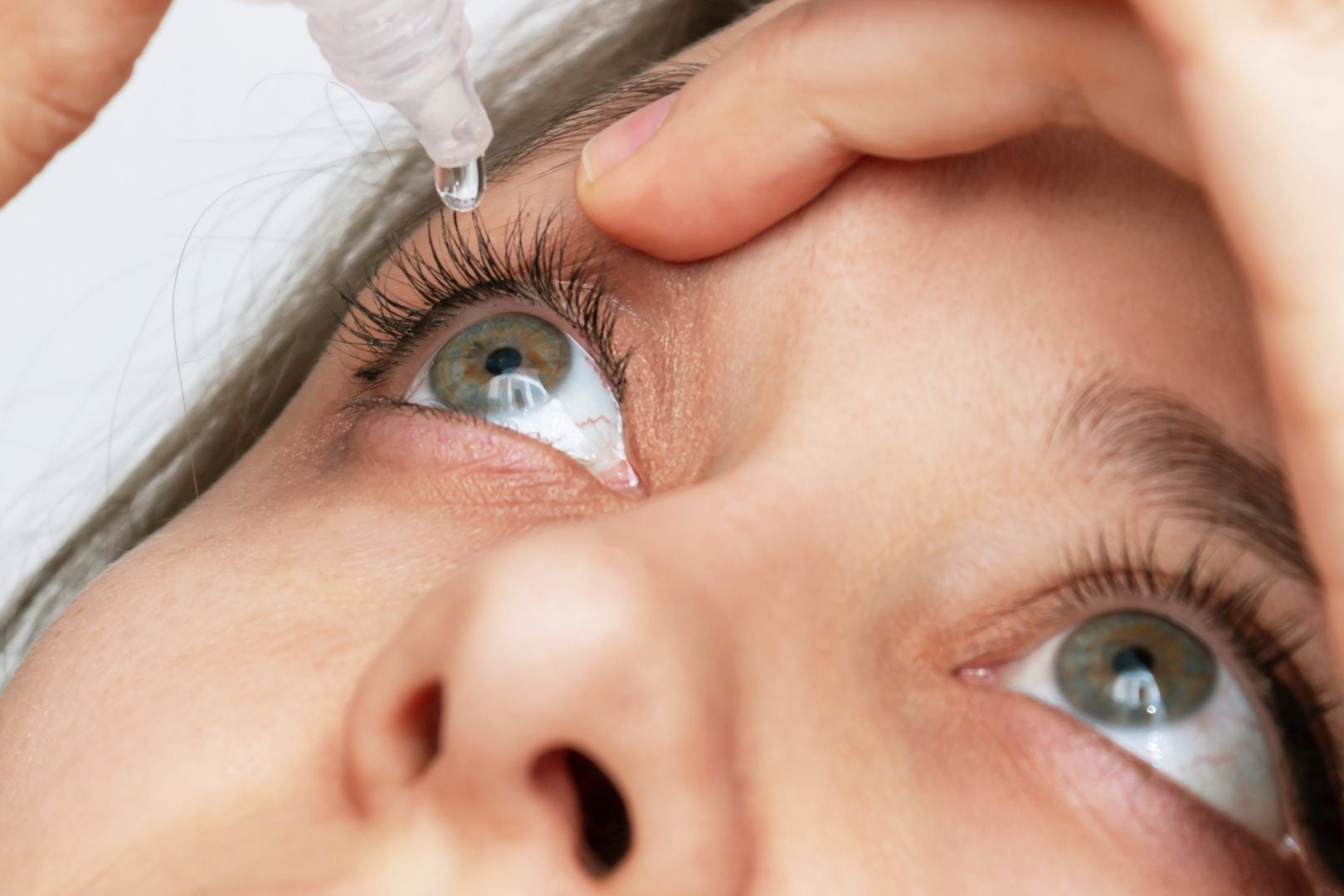Blepharitis
If your eyes often feel irritated, gritty, or watery, or if you’re waking up with crusty lashes, red lids, or recurring styes, you might be dealing with blepharitis—a chronic inflammation of the eyelid margins that affects millions of people, often without a clear diagnosis.
It may not be serious in its early stages, but blepharitis can cause persistent discomfort, interfere with vision, and contribute to more serious issues like Meibomian Gland Dysfunction (MGD) and Dry Eye Disease if left untreated.
So, What Exactly Is Blepharitis?
Blepharitis is an inflammatory condition of the eyelids, usually involving:
- The skin at the base of the lashes
- The openings of the meibomian (oil) glands
- The surrounding tissue of the eyelid margins
The causes are multifactorial, often involving:
- Bacterial overgrowth
- Skin conditions like seborrhoeic dermatitis or rosacea
- Microscopic mites (Demodex)
- Hormonal changes or immune imbalance
- Long-term makeup use, poor lid hygiene, or environmental irritants
Blepharitis is not contagious, but it is often chronic, meaning it can flare up repeatedly without ongoing care. Common Symptoms Include:
- Red, inflamed eyelid margins
- Crusts or flakes on lashes (especially in the morning)
- Burning, gritty or itchy eyes
- Watery eyes (especially outdoors or in wind)
- Foreign body sensation
- Eyelash thinning, breakage, or misdirection
- Recurrent styes or chalazia
- Eye fatigue and blurred vision that improves with blinking
The 3 Main Types of Blepharitis
Staphylococcal Blepharitis
Caused by an overgrowth of Staphylococcus bacteria—naturally found on our skin but problematic when they disrupt the delicate eyelid environment.
Typical Signs
- Crusting and scabbing at lash roots
- Lid swelling and irritation
- Inflammation that may damage the lash follicles over time
- Often seen in children and young adults, but can affect anyone
Evidence-based Care
- Professional Lid Cleansing
- Lid hygiene and antimicrobial lid cleansers
- Topical antibiotic or steroid drops/ointments (in acute cases)
- Avoiding irritants such as expired makeup or heavy creams
Seborrhoeic Blepharitis
Associated with seborrhoeic dermatitis—a skin condition that causes excess oil and flaking. The oil mixes with debris at the base of the lashes, creating inflammation.
Typical Signs
- Oily, greasy debris along lashes
- Mild redness or swelling
- Often seen in combination with dandruff, oily scalp, or facial redness
Evidence-based Care
- Daily warm compresses and eyelid cleansers (foam or pads)
- Treatment of underlying scalp or facial dermatitis
- IPL therapy or omega-3 supplementation (if combined with MGD)
Demodex Blepharitis
Demodex blepharitis is a common but often overlooked cause of chronic eyelid irritation, styes, lash loss, and dry eye symptoms. It is caused by Demodex mites, microscopic organisms that naturally inhabit the hair follicles of our skin—including the eyelashes and eyebrows.
While most people have a small population of these mites without any symptoms, an overgrowth—often triggered by age, skin conditions, or immune factors—can cause significant inflammation and discomfort around the eyes.
Recognising Demodex Blepharitis
The hallmark clinical sign of Demodex blepharitis is the presence of collarettes—cylindrical, waxy deposits at the base of the lashes. These are made up of mite waste and skin debris, and their presence is considered pathognomonic (distinctively diagnostic) for Demodex infestation.
Key symptoms include
- Itchy, irritated, or burning eyelids (especially in the morning)
- Red or inflamed eyelid margins
- Crusting or scaling around the lashes
- Recurrent styes or chalazia
- Misaligned, brittle, or falling lashes
- Gritty sensation or eye fatigue
Demodex-related symptoms are often misdiagnosed as general blepharitis or dry eye disease, so correct identification is key to getting effective treatment.
Prevalence and Risk Factors
Demodex becomes increasingly common with age:
- ~84% of people over age 60
- 100% of individuals over age 70
-
Other risk factors include:
- Rosacea (Demodex prevalence is up to 9x higher
- Seborrhoeic dermatitis
- Chronic eyelid inflammation or long-term blepharitis
- Use of oily makeup, poor lid hygiene, or lash extensions
Impact on Dry Eye Disease
Demodex mites can:
- Block meibomian glands, reducing the oily layer of the tear film
- Disrupt tear film stability, leading to increased evaporation
- Cause inflammation, worsening symptoms of dry eye
- Trigger MGD, styes, or chalazia due to blocked oil glands
This creates a vicious cycle of irritation, gland dysfunction, and ocular surface inflammation.
Traditional treatments often focused on basic lid hygiene and tea tree oil-based products—but today, we offer targeted, advanced therapies that improve comfort, reduce mite populations, and restore healthy lid function.
Depending on the severity of your Demodex blepharitis, your treatment plan may include ZEST (Zocular Eyelid System Treatment), IPL (Intense Pulsed Light), Tixel-i®, LLLT (Low-Level Light Therapy) and Home management routines.
Why Consistency Matters
Demodex mites have a two-week life cycle, meaning that ongoing treatment is essential to fully clear them and prevent reinfestation.
At Illume, we recommend follow-up treatment every 2 weeks after the initial visit with Demodex with continued in-practice sessions until no visible collarettes remain, then ongoing home care to maintain results and prevent recurrence.
Even after symptoms improve, maintenance therapy is often needed to keep the mite population in check—especially in patients with rosacea or chronic MGD.
Our Approach at Illume
At Illume, we offer a comprehensive approach to blepharitis management using the latest diagnostic tools and treatments tailored to your needs. This includes:
- Detailed diagnosis using slit-lamp examination, imaging, and mite identification
- Personalised home care routines to maintain lid health long-term
- In-practice lid cleaning (ZEST) to remove debris, mites, and biofilm
- Thermal therapies (LipiFlow®, Tixel-i®, IPL) if MGD is also present
- Prescription treatments for inflammation, infection, or skin-related flare-ups
- Education and prevention—because blepharitis is chronic, but manageable with the right plan
You don't have to live with irritated eyes. With the right diagnosis and care, blepharitis can be controlled—and your eyes can feel comfortable again.
Management Options for Blepharitis
In-Practice Lid Cleansing: A Clean Start for Healthier Eyes
When it comes to managing blepharitis and meibomian gland dysfunction (MGD), proper eyelid hygiene is essential—but in many cases, at-home routines alone aren’t enough. That’s why we offer in-practice lid cleansing treatments, including ZEST and NuLids, to give your eyes a clean, comfortable, and healthy foundation for long-term success.
These treatments are ideal as an early intervention or in conjunction with our advanced therapies to rapidly improve comfort, appearance, and lid function.
ZEST (Zocular Eyelid System Treatment)
ZEST is a soothing in-clinic procedure that uses a natural okra-based gel to deeply cleanse and exfoliate the lash line. It removes:
- Biofilm and bacteria
- Blocked debris from meibomian gland openings
- Residue from skin conditions like seborrhoeic dermatitis
- Demodex mite waste products (linked to inflammation and lash loss)
Developed by an ophthalmologist, ZEST is safe, gentle, and well-tolerated by most skin types—and leaves your eyelids feeling clean, refreshed, and soothed.
NuLids: Precision Stimulation & Exfoliation
NuLids is a soft-tip oscillating device designed to gently exfoliate the eyelid margins and stimulate oil gland function. It’s ideal for patients with:
- Thickened, inflamed lid margins
- Recurrent blepharitis or styes
- Poor blink mechanics or contact lens-related lid irritation
NuLids can be used in-practice or prescribed for guided home use in chronic cases.
Combination Therapy for Lasting Results
To maximise results, ZEST and NuLids are often combined with advanced in-practice treatments that target underlying inflammation and gland dysfunction, including:
- IPL (Intense Pulsed Light) – Reduces inflammation, kills surface Demodex mites, and improves meibomian gland output.
- Tixel-i® – Stimulates cellular renewal and gland activity while also disrupting the Demodex environment.
- LLLT (Low-Level Light Therapy) – Reduces inflammation, promotes healing, and supports the body’s natural immune response against Demodex and other irritants.
- LipiFlow® – Combines heat and pulsation to clear blocked glands and restore oil flow to the tear film.
These treatments can work synergistically—cleansing the lids with ZEST or NuLids prepares the area for deeper treatments, allowing IPL, Tixel-i®, or LipiFlow to perform more effectively.
What to Expect During Your In-Practice Cleanse
Each session typically takes 15–20 minutes and includes:
- Assessment & Preparation – We’ll examine your lids and explain your personalised treatment plan.
- ZEST &/or NuLids Application – A gentle cleanse using natural gel and/or exfoliating device to remove buildup and unblock glands.
- Post-cleanse care – Rinse and soothe the area, sometimes followed by heat therapy, expression, or light-based treatments for deeper results.
Patients often describe it as a relaxing, spa-like experience for their eyes, with immediate freshness and continued improvement over days to weeks.
Why This Step Matters
In-practice lid cleansing is often the first and most important step in successfully managing blepharitis and dry eye. It:
- Provides rapid symptom relief
- Clears debris that blocks oil glands and harbours mites
- Improves response to prescription drops and light-based therapies
- Enhances comfort, reduces flare-ups, and helps prevent styes

